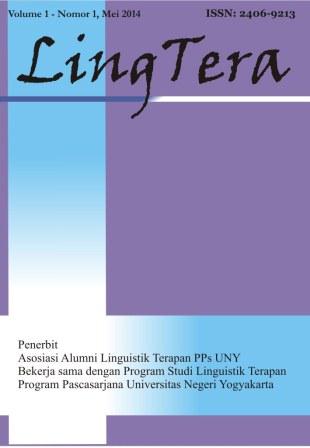The effectiveness of using multiple intelligence activities in listening comprehension and improving students' interest
DOI:
https://doi.org/10.21831/lt.v6i2.10625Keywords:
ultiple intelligences, listening comprehension, students' interestAbstract
This study aims to find out (1) the effectiveness difference between the use of multiple intelligence activities and the conventional activities in listening comprehension, and in the students' interest in learning English. This study used the quantitative method. The study design was quasi- experimental with the pre-test and the post-test group design. The experimental class used 5 categories of multiple intelligences namely; linguistic intelligence, logical/mathematical intelligence, visual intelligence, musical intelligence, and naturalist intelligence. This study used a listening comprehension test and a questionnaire as the research instruments for collecting the data. The technique of the data analysis in this study was MANOVA. The result shows that: (1) the use of multiple intelligence in listening comprehension is more effective than the conventional activities with sig 0.000; (2) the use of multiple intelligence activities in students' interest in learning English is more effective than the conventional activities with sig 0.000.
References
Abdi, A., Laei, S., & Ahmadyan, H. (2013). The effect of teaching strategy based on multiple intelligences on students' academic achievement in science course. Universal Journal of Educational Research, 1(4), 281–284. https://doi.org/10.13189/ujer.2013.010401
AL-Zyoud, N. fahmi, & Nemrawi, Z. mohammad. (2015). The efficiency of multiple intelligence theory (MIT) in developing the academic achievement and academic-self of students with mathematical learning disabilities in the areas of addition, subtraction and multiplication. American International Journal of Social Science, 4(2), 171–180. Retrieved from http://www.aijssnet.com/journals/Vol_4_No_2_April_2015/16.pdf
Armstrong, T. (2009). Multiple intelligences in the classroom. ASCD.
Buck, G. (2001). Assessing listening. Cambridge University Press.
Dunkel, P. A. (1986). Developing listening fluency in L2: Theoretical principles and pedagogical considerations. The Modern Language Journal, 70(2), 99–106.
Gardner, H. (1993). Multiple intelligences: The theory in practice. New York: Basic Books.
Gardner, H., & Moran, S. (2006). The science of multiple intelligences theory: A response to Lynn Waterhouse. Educational Psychologist, 41(4), 227–232. https://doi.org/10.1207/s15326985ep4104_2
Hidi, S., & Renninger, K. A. (2006). The four-phase model of interest development. Educational Psychologist, 41(2), 111–127. https://doi.org/10.1207/s15326985ep4102_4
Ibnian, S., & Hadban, A. (2013). Implications of multiple intelligences theory in ELT field. International Journal of Humanities and Social Science, 3(4), 292–297.
Krapp, A. (2002). An educational-psychological theory of interest and its relation to SDT. In The Handbook of self-Determination Theory (pp. 405–427). Retrieved from http://philpapers.org/rec/KRAAE-3
Morley, J. (2001). Aural comprehension instruction: Principles and practices. In Teaching English as a second or Foreign Language (Vol. 3, pp. 69–85). Oxford, UK: Heinle & Heinle.
Noom-Ura, S. (2013). English-teaching problems in Thailand and Thai teachers' professional development needs. English Language Teaching, 6(11), 139–147. https://doi.org/10.5539/elt.v6n11p139
Phillips, H. (2010). Multiple intelligences: Theory and application. Perspectives In Learning, 11(1), 4.
Sariolghalam, N., Noruzi, M. R., & Rahimi, G. R. (2010). The enigma of Howard Gardner's multiple intelligences theory in the area of organizational effectiveness. International Journal of Business and Management, 5(5). https://doi.org/10.5539/ijbm.v5n5p161
Stanford, P. (2003). Multiple intelligence for every classroom. Intervention in School and Clinic, 39(2), 80–85. https://doi.org/10.1177/10534512030390020301
Taase, Y. (2012). Multiple intelligences theory and Iranian textbooks : An analysis. Pan-Pacific Association of Applied Linguistics, 16(1), 73–82.
Vandergrift, L. (2007). Recent developments in second and foreign language listening comprehension research. Language Teaching, 40(3), 191–210. https://doi.org/10.1017/S0261444807004338
Downloads
Published
How to Cite
Issue
Section
Citation Check
License
LingTera allows readers to read, download, copy, distribute, print, search, or link to its articles' full texts and allows readers to use them for any other lawful purpose. The journal allows the author(s) to hold the copyright without restrictions. Finally, the journal allows the author(s) to retain publishing rights without restrictions.
- Authors are allowed to archive their submitted articles in an open-access repository.
- Authors are allowed to archive the final published article in an open-access repository with an acknowledgment of its initial publication in this journal.

Psychology, Evaluation, and Technology in Educational Research is licensed under a Creative Commons Attribution-ShareAlike 4.0 International License.
Based on a work at https://petier.org/index.php/PETIER.










